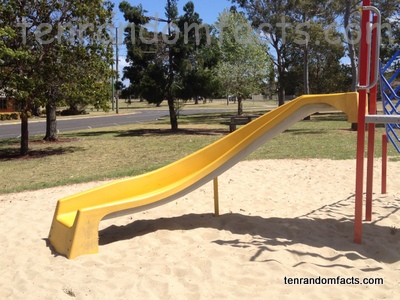Don’t you like sliding down playground slides?
- Playground slides are entertainment constructions often placed in recreational areas or residential backyards, as well as amusement parks.
- ‘Playground slides’ are also known as ‘slides’, ‘slippery dips’ and ‘slippery slides’.
- Playground slides are often a slippery, flat or partially curved strip of material, with barriers on the left and right, either perpendicular or sloped.
- Playground slides are used by people, typically children, by them climbing up a ladder or set of stairs to reach the top of the slide, sitting on their backside at the top; and pushing themselves forward so that they are propelled down the slide’s strip.
- Playground slides are commonly curved in some form, often around a structure, while some are completely enclosed, and they come in a variety of colours.
- Although fun, playground slides can be quite dangerous; injuries such as bruises, scrapes, cuts and broken bones can occur, often due to an unsafe user or slide, such as a high drop.
- Playground slides are typically made of plastic, wood and/or metal, although the latter often heats up in the sun and can cause burns.
- Adults often slide down playground slides with their children, although it is a common cause of broken legs in young children, due to the possibility of the child’s foot catching onto the slide and the force of the parent’s movement pushing the child forward with their foot still caught.
- The origin of playground slides is uncertain, although one of the first slides patented was possibly by James Kirker of Kentucky in the United States in 1893, which was intended as a fire escape, however earlier patents exist for water slide designs, and slides were being constructed by the beginning of the 1900s.
- Many laws have been passed regarding the legality and guidelines of construction and placement of playground slides, particularly regarding protruding devices and the slide drop.
Bibliography:
Erickson A, The Politics of Playgrounds, a History, 2012, Citylab, http://www.citylab.com/design/2012/03/politics-playgrounds-history/1480/
Kirker, J 1893, ‘Fire-escape’, US506238, 10 October, p. 1, Google Patents, Google
Playground Slide, 2014, Wikipedia, http://en.wikipedia.org/wiki/Playground_slide






